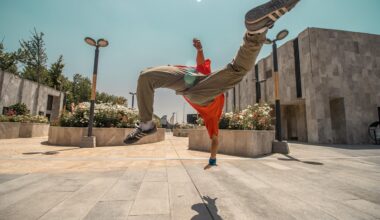How To Use Diaphragmatic Breathing During Senior Workouts
Diaphragmatic breathing is a fundamental technique that can significantly enhance performance for seniors during workouts. This method engages the diaphragm muscle more than traditional shallow breathing, improving oxygen intake and promoting relaxation. In seniors, increased lung capacity through this technique can help mitigate issues such as shortness of breath during physical activities. Additionally, diaphragmatic breathing helps in stabilizing core muscles, which is vital for maintaining proper posture during various exercises. Engaging in regular diaphragmatic practices can lead to improved endurance and overall fitness levels. To start with this approach, seniors can practice inhaling deeply through the nose, allowing the abdomen to expand rather than the chest. Holding this breath for a few seconds before exhaling powerfully helps train the diaphragm. Incorporating this breathing technique into daily physical activities can yield profound benefits that go beyond just workout sessions. Notably, it aids in stress relief and promotes a greater sense of well-being. With a little practice, mastering diaphragmatic breathing can lead to substantial improvements in workout efficiency and satisfaction.
Understanding the importance of breath control can elevate workout experiences for seniors. By connecting breath with movement, seniors can execute exercises more effectively. Diaphragmatic breathing serves this purpose by fostering a deeper connection between the mind and body during physical exertion. Seniors often face limitations due to age-related changes in lung capacity and muscle strength. Using diaphragmatic techniques can help counteract these limitations. Examples of simple exercises that incorporate this breathing method include walking, yoga, or gentle stretching. Before starting these exercises, seniors should be aware of their limits and adjust their routines accordingly. Gradually introducing diaphragmatic breathing while engaging in these activities can enhance their effectiveness. Participating in senior fitness classes may also benefit those who prefer a structured environment. Many classes focus on incorporating breathing exercises within each session, promoting a holistic approach to fitness. As seniors adopt this technique, they may notice reduced fatigue, improved stamina, and heightened enjoyment during workouts. Breathing deeply during exercise not only relaxes the body but also enhances mental focus, leading to a more fruitful workout experience.
The Mechanics of Diaphragmatic Breathing
To effectively implement diaphragmatic breathing, it’s crucial to understand its mechanics. The diaphragm is a dome-shaped muscle located beneath the lungs that plays a pivotal role in breathing. When you inhale through your nose and engage your diaphragm properly, your belly should rise as air fills the lower lungs. In contrast, shallow breathing mostly utilizes the upper lungs, which can lead to inefficient oxygen exchange. To practice diaphragmatic breathing, seniors can start by lying on their back or sitting comfortably in a chair. Placing a hand on the belly can provide feedback about rising and falling during breaths. Inhaling for a count of four, holding for two, then exhaling for a count of six can help establish a rhythm. Over time, adjusting the counts can lead to improved lung capacity. Incorporating this breathing technique into a regular routine will allow seniors to harness the full power of their lungs. Consistent practice not only enhances physical fitness during workouts but can also improve respiratory health and mobility, granting more freedom during daily activities.
There are specific exercises that naturally pair well with diaphragmatic breathing. Gentle activities like stretching, tai chi, or even light resistance training can benefit enormously from this technique. For instance, while stretching, seniors can inhale deeply as they stretch and exhale while returning to a neutral position. This prime breath-work connection can help deepen stretches, enhancing flexibility with each inhalation. Tai chi focuses on slow motion, rhythm, and breath, making it an excellent option for seniors. The incorporation of breath keeps movements smooth and controlled, reducing the risk of falls while also promoting relaxation. Similarly, during resistance training, seniors can apply diaphragmatic breathing as they exert effort, ensuring they do not hold their breath. This approach prevents unnecessary strain and promotes safety while lifting weights. Additionally, seniors might find it beneficial to combine breathing exercises with leisure walks. Engaging with nature while focusing on breathing patterns can soothe the mind and body. All these methods work synergistically to foster health and well-being in seniors looking to enhance their fitness journey.
Benefits of Diaphragmatic Breathing
The benefits of diaphragmatic breathing for seniors extend into various aspects of health and well-being. One of its most significant advantages is stress reduction; it promotes relaxation through the activation of the parasympathetic nervous system. As stress levels decrease, seniors may find it easier to maintain consistent workout habits and tackle physical challenges. Improved oxygenation from deeper breaths ensures cells receive adequate energy, which can support overall health. This technique also aids in reducing blood pressure, providing cardiovascular benefits. Higher oxygen levels can enhance circulation, leading to better nutrient delivery throughout the body. Moreover, engaging in diaphragmatic breathing can improve lung function, which often declines with age. Strengthening the diaphragm means that seniors can take deeper, more effective breaths, counteracting age-related respiratory issues. Additionally, participants may notice an improvement in their mental clarity as enhanced oxygenation boosts cognitive function. Incorporating diaphragmatic breathing into a daily routine can foster improved mood and emotional resilience, empowering seniors to approach challenges with confidence and optimism. Consistency is key to harnessing these benefits in the pursuit of a healthier lifestyle.
As seniors embark on their fitness journey, integrating diaphragmatic breathing can be incredibly empowering. This technique is not merely a tool for exercise; it serves as a foundation for overall well-being. It can be particularly beneficial for seniors recovering from illness or those facing mobility challenges by enhancing their ability to engage in physical activities. Awareness of breath allows seniors to tune into their bodies’ needs, enabling a more mindful approach to workouts. Emphasizing the significance of good posture while breathing adds another layer of benefit, supporting core muscles effectively. Moreover, practicing diaphragmatic breathing can serve as a form of meditation, encouraging seniors to cultivate mindfulness during their workouts. Being present in the moment helps shift focus away from potential discomfort or fatigue, enhancing the exercise experience. To maximize this technique, seniors can invite friends or family members to join them in practice. Sharing experiences together can create a supportive network, fostering commitment and joy in fitness activities. As relationships strengthen, it can also improve social engagement, ultimately enriching their overall quality of life.
Conclusion
In summary, diaphragmatic breathing is a precious asset for seniors engaging in workouts. Its numerous benefits include improved oxygenation, enhanced lung capacity, reduced stress, and increased physical performance. Seniors can positively impact their health by adopting this technique into their daily routines. Starting with simple practices and gradually integrating breathing into various workouts allows them to capitalize on its advantages. Whether participating in fitness classes, solo workouts, or gentle activities, seniors can reap rewards through consistent practice of diaphragmatic breathing. As they learn more about this technique, seniors might find excitement and satisfaction in observing their physical progress and mental well-being. Sharing their journey with others can create community bonds that boost motivation, leading to healthier lifestyle choices. It is prudent for seniors to consult health professionals before starting new activities, ensuring any safety concerns are addressed. Continuing to learn and adapt in their fitness journey ensures success and fulfillment during later years. With determination, skills, and support, seniors can embrace a healthier and more vibrant life through effective breathing techniques.
From this article, it is evident that diaphragmatic breathing is not just a practice; it is a pathway to empowering seniors on their fitness journey. Each aspect discussed reflects how this technique integrates seamlessly into various exercise modalities, promoting better health outcomes. The philosophy behind breathing extends beyond physical improvements to mental clarity and emotional stability. By fostering awareness and understanding of breath, seniors learn to cultivate a more profound connection with themselves. The benefits of diaphragmatic breathing reinforce the idea of a holistic approach to senior fitness, where both mind and body work in harmony. By committing to consistent practice, seniors can experience tangible benefits in their workouts. This method requires little equipment or investment, making it an accessible option for most. As they embark on this path, seniors will not only improve their physical capabilities but also their overall quality of life, increasing feelings of vitality and well-being. Embracing this technique within their routines empowers individuals, reminding them that they have the ability to enhance their lives at any age. Ultimately, the principles of diaphragmatic breathing redefine wellness for seniors, fostering a healthier, active, and fulfilling lifestyle.


